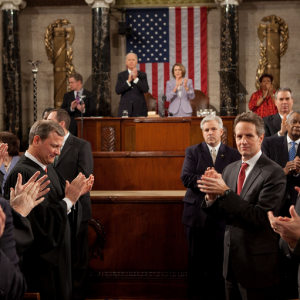When President Barack Obama fulfills his constitutional duty and delivers the State of the Union Address on Jan. 20, most observers will expect the usual “conversation” with Congress – and the American public – about his near-term agenda and long-term vision for the Republic.
What’s different about this year’s speech is that Obama has a new Republican-led Congress to deal with, one with its own agenda. Nowhere is this more visible than on energy issues.
From the pending vote in the Senate on the Keystone XL pipeline, to debate over oil and natural gas exports, to job creation and tax reform, the question of how to shape policy to sustain and grow America’s 21st Century Renaissance are at the top of Washington’s to-do list.
For their part, House Republicans have released a detailed plan to invest in critical infrastructure projects, an “architecture of abundance” to take advantage of what now looks like a global leadership in oil and natural gas production. From my own point of view, not only would Keystone XL be a linchpin of this new “architecture” but other proposed building blocks need to move forward.
Indeed, expanded pipeline infrastructure is absolutely vital to sustaining our energy boom, but foot-dragging by the White House and its friends in (the old) Congress has put infrastructure projects on hold, and they’ve worked hard to constrict, not expand, policies that would strengthen America’s new-found energy independence. “Creating this architecture of abundance is slowed at every step by archaic federal rules that can cause years of delays and even block some pipeline and power line projects outright,” House Republicans said in a statement.
Another urgent policy need is a reconsideration of energy export restrictions – policies enacted when energy “scarcity” was the prevailing view – to better maximize the impact of American crude and natural gas in a world hungry for energy. But, again, we’ve seen more in the way of delaying tactics than support from the White House. It’s important to keep in mind that boosting exports will draw massive new investment and further bolster our ability to meet future domestic demand while enabling us to make good use of excess supply on the global market. The U.S. Energy Information Industry projects that even 25 years out, crude oil, natural gas and coal will continue supply 80 percent of our nation’s energy needs.
President Obama talks a good game on energy. In last year’s State of the Union Address, the president said his all-of-the-above energy policy “is working, and today, America is closer to energy independence than we’ve been in decades.” The fact of the matter is that our oil and natural gas surge has largely taken place on state-owned and private lands while the president has put “off limits” signs up around the vast tracts of property owned by the federal government, not to mention offshore coastal zones.
Last year, Obama repeated the White House mantra about “Big Oil” unfairly receiving corporate welfare and subsidies, saying he’d work for a “smarter tax policy that stops giving $4 billion a year to fossil fuel industries that don’t need it, so that we can invest more in fuels of the future that do.”
The facts of the matter are that the domestic energy industry – the sparkplug of our economic rebound since the Great Recession – doesn’t receive subsidies. The tax provisions that the White House wants to deny oil and gas firms selectively are cost recovery mechanisms, many of which are widely used in other manufacturing sectors. If we want to have “an adult conversation” about tax reform, let’s do that. But vilifying an energy sector that employs nearly 10 million Americans (one which already pays tax rates far above S&P 500 average) and using pejorative language to describe its actions, is not how we’re going to end legislative gridlock and the polarization of politics in our nation’s capital.
What has the American energy industry done with its profits? It has massively invested in new and cleaner technologies, resource development, and job creation.
Since 1990, the oil and natural gas sector has plowed $284 billion into improving the environmental performance of its products, facilities and operations, according the American Petroleum Institute. From 2000 through 2012, the industry has spent more on low and zero-carbon emitting technologies than the federal government has spent, “and that total is nearly as much as all other industries’ spending on these technologies combined.”
Domestic energy companies comprised the second most active group of investors, behind only telecom and cable, in the Progressive Policy Institute’s 2014 “Investment Heroes” ranking. Six energy companies accounted for a total of $40 billion in private, domestic capital spending. This investment is sparking huge job growth nationwide – growth that’s felt acutely in the African American and Hispanic communities.
The new Congress, emboldened by a November election which sent pro-energy candidates into Congress and state houses in record numbers, wants to sustain economic growth and energy security. The president wants this too – and would do well in his State of the Union speech to eschew the partisan talking points and political posturing that has characterized too much of his policies in energy. The American people will be listening for a change in tone and tangible progress that puts our nation’s interests at the top of his agenda.

